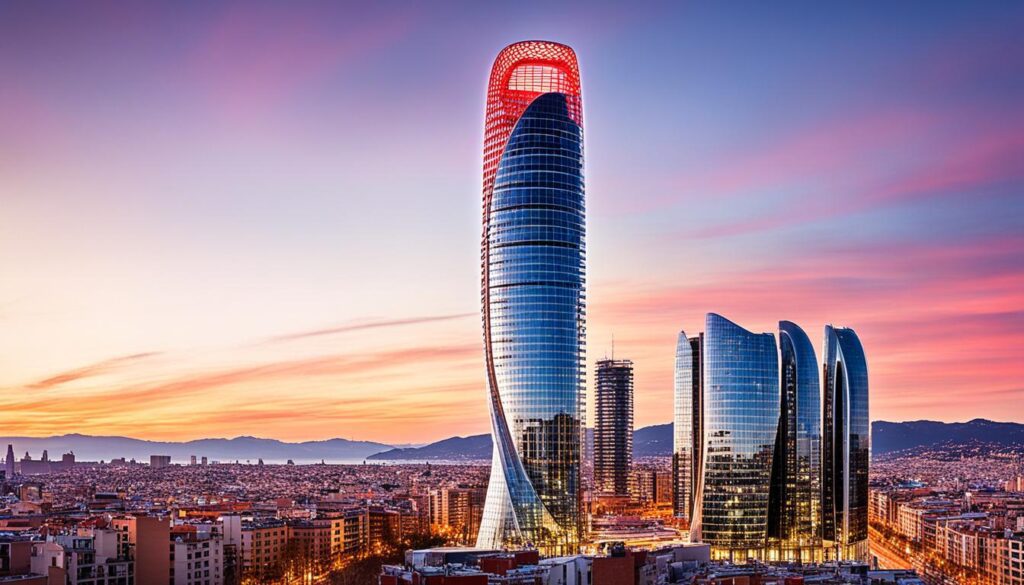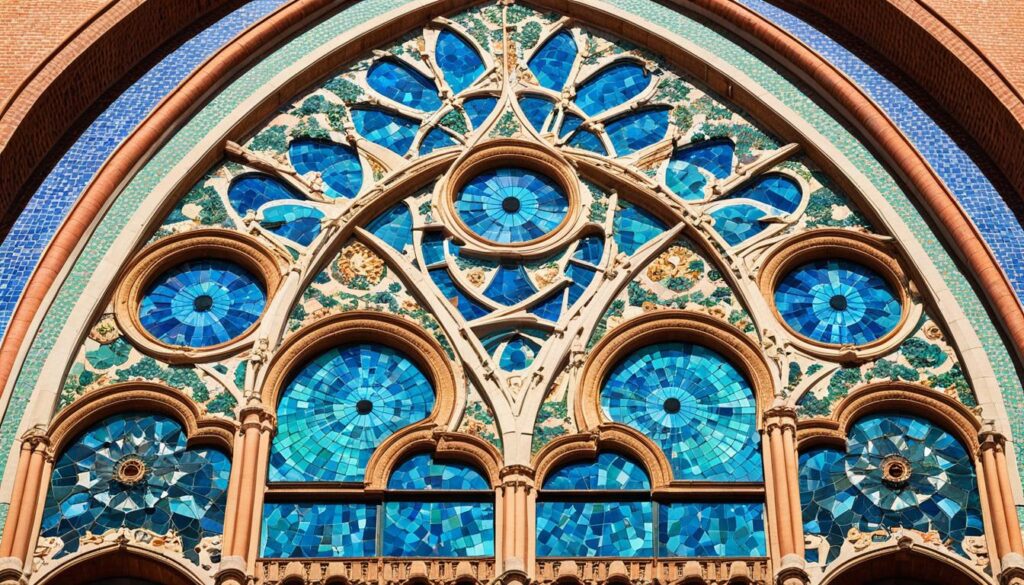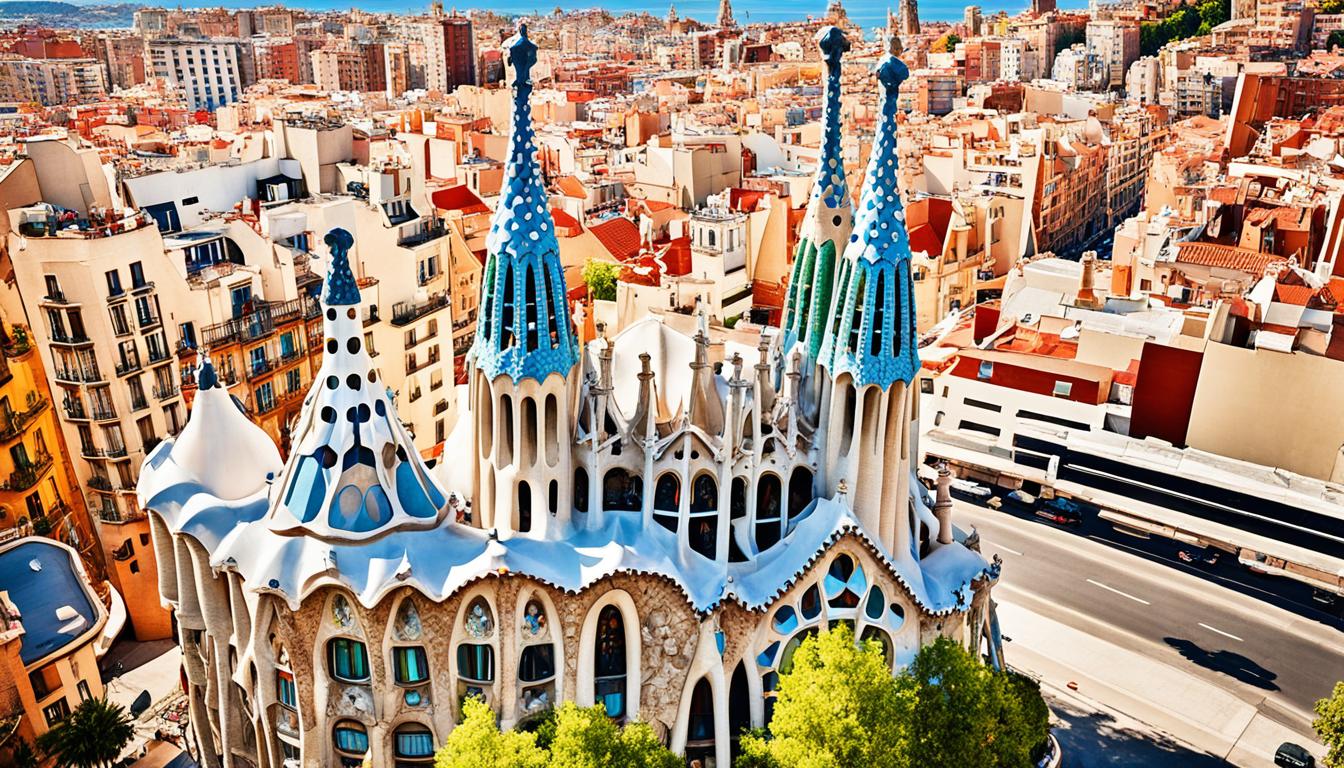Barcelona is known for its stunning architecture. It has Gothic cathedrals, Modernisme creations, and avant-garde works. The city’s building boom started in the late Middle Ages, when it was a key part of the Catalan empire.
In the late 1800s, Barcelona changed a lot with the Modernisme movement. This era is still going on today. Modernisme is Barcelona’s big gift to the world. It started in the late 1800s and is known for its vibrant style.
Antoni Gaudí is a key figure in Modernisme. He changed the world of architecture with his unique designs.
Key Takeaways
- Barcelona is famous for its mix of architectural styles, from Gothic to Modernisme.
- Modernisme changed the city in the late 1800s, with Antoni Gaudí leading the way.
- The city’s architecture combines old and new, making it visually stunning.
- Barcelona’s buildings show its deep history and culture, with each area having its own style.
- Its architecture draws millions of visitors each year, making it a top tourist spot.
Introduction to Barcelona’s Architectural Wonders
Barcelona is famous for its stunning architecture. It has a mix of styles that make its cityscape unique. The city is known for barcelona architecture, spanish modernism, and catalan modernism. These styles show the creativity of its designers.
Barcelona’s Architectural Gift: Modernisme Movement
The modernisme movement started in the late 19th century in Barcelona. It was a time of artistic and architectural change. This style is known for its detailed, organic designs and bright colors.
Antoni Gaudí was a key figure in this movement. He started his career at 26 with a project in Paris. His work, like the Casa Batlló and Sagrada Familia, has made Barcelona famous.
“Barcelona’s architectural landscape boasts over two millennia of history, with seven out of nine UNESCO World Heritage Sites in the city created by the visionary Antoni Gaudí.”
Other architects like Lluís Domènech i Montaner and Josep Puig i Cadafalch also shaped Barcelona’s look. They added to the city’s architectural beauty.
Places like the Recinte Modernista de Sant Pau and Mercat de Santa Caterina show Barcelona’s love for art and innovation. These spots inspire visitors with their beauty.
La Sagrada Família: Gaudí’s Unparalleled Masterpiece
The La Sagrada Família rises high above Barcelona, showing off Antoni Gaudí’s incredible vision. This work of art has amazed people for over a hundred years. Its tall design and detailed work make everyone who sees it feel amazed.
Building the Barcelona cathedral started in 1882, but it’s still not done. It’s expected to finish in 2026, a hundred years after Gaudí died. Even though it took a long time, the Sagrada Família welcomes over 4.5 million visitors every year. It’s the most visited spot in Spain and a key example of Spanish modernist architecture.
Gaudí mixed medieval cathedrals with his Modernisme style to create something amazing. The Sagrada Família has tall spires and a detailed facade. Every part of it shows Gaudí’s unique vision and his hard work on the project.
“The Sagrada Família is a unique work of art, with no precedent. It is a synthesis of all the arts.”
People can’t wait for the Sagrada Família to be finished. It keeps amazing and inspiring everyone. It shows the lasting impact of Gaudí’s creative ideas and human determination.
Barcelona’s Gothic Marvel: Basílica de Santa Maria del Mar
At the southwestern end of Passeig del Born, you’ll find the Basílica de Santa Maria del Mar. This stunning Catalan Gothic church started in 1329. Architects Berenguer de Montagut and Ramon Despuig oversaw its construction.
The basilica’s design shows the hard work of the local people, especially the stevedores from the port. They helped build it.
A Harmonious Blend of Catalan Gothic Architecture
The Basílica de Santa Maria del Mar is famous for its Catalan Gothic style. It features soaring columns, detailed rose windows, and a focus on height and light. Inside, you’ll find wide naves, decorated altars, and stained glass windows that fill the space with color.
Building the basilica was quick, taking just 54 years. That was fast for its time. The columns are far apart, 13 meters, which was a big deal back then.
This basilica is important to Barcelona’s culture. It’s been a place of worship, seen royal weddings, and witnessed important events. Antoni Gaudí was inspired by it when making the Sagrada Familia.
“The Basílica de Santa Maria del Mar is a true testament to the enduring spirit of the Catalan people, who came together to create this architectural gem that continues to captivate visitors from around the world.”
Contemporary Additions to Barcelona’s Skyline
Barcelona’s architecture is famous for works by Antoni Gaudí and others. But, the city also loves modern design. The 38-story Torre Glòries, by Jean Nouvel, is a key modern addition.
Since 2005, the Torre Glòries has caught eyes with its unique “cucumber” shape. At night, it shines in midnight blue and red, showing off Barcelona’s love for contemporary architecture. This tower changes the city’s look with its bold design.

The Torre Glòries shows Jean Nouvel’s mix of function and art. Its eye-catching look and smart lighting make it a key part of barcelona contemporary architecture. People from all over come to see its beauty.
Buildings like the Torre Glòries remind us Barcelona’s architecture is always moving forward. It’s a place where new designs and tech shape the city’s future. This makes Barcelona’s skyline exciting and full of life.
Palau de la Música Catalana: A Symphony in Tile and Glass
In the heart of Barcelona lies the Palau de la Música Catalana, a true architectural wonder. It combines the beauty of Catalan modernisme with the magic of natural light. This UNESCO-listed concert hall was built from 1905 to 1908 for the Orfeó Català, a key player in Catalan culture.
The Palau de la Música Catalana showcases the modernisme style with its vibrant shapes and rich details. Its design takes inspiration from Spanish and Arabic architecture, creating a captivating look. Inside, you’ll find glazed ceramic stars and colorful tiles that add to its charm.
The concert hall is a sight to behold, lit by a huge skylight and stained-glass windows. It also features a grand pipe organ and bronze busts of musicians. These elements highlight the Palau’s deep musical roots and cultural importance.
In 1997, the Palau de la Música Catalana was named a UNESCO World Heritage Site. This honor celebrated its role in the Catalan renaissance and its modernisme architecture. Now, it welcomes over half a million visitors each year, who come to enjoy its stunning performances.
“The Palau de la Música Catalana is a true symphony in tile, brick, sculpted stone, and stained glass, a testament to the artistry and cultural pride of Catalonia.”
Recinte Modernista de Sant Pau: Domènech i Montaner’s Lavish Masterpiece
Barcelona’s architecture is full of styles, but the Recinte Modernista de Sant Pau stands out. It’s a Modernista-style complex by Lluís Domènech i Montaner. Built from 1901 to 1930, it’s a 27-building ensemble showing the beauty of Catalan Modernist art.
A Unique Complex of Modernista-Style Buildings
The Recinte Modernista de Sant Pau was meant to be the Hospital de la Santa Creu i de Sant Pau, a cutting-edge medical center for Barcelona. But Domènech i Montaner made it more, turning it into a stunning work of art. It combines Modernista architecture with Art Nouveau elements.
The complex has 16 pavilions with detailed stone carvings, bright ceramic tiles, and whimsical ironwork. These elements bring nature into the buildings. The complex’s shapes, colors, and garden setting offer a deep dive into Modernista style.
“The artwork and decoration of the Hospital de Sant Pau resemble a grand house rather than a hospital.”
In 2007, the Recinte Modernista de Sant Pau became a UNESCO World Heritage Site. It joined Barcelona’s famous modernisme sites like the Palau de la Música Catalana and Antoni Gaudí’s works.

Now, the Recinte Modernista de Sant Pau honors Lluís Domènech i Montaner’s vision. It’s a key figure in Catalonia’s modernisme movement. Visitors can learn about its history and admire its architecture through tours and self-guided visits.
Mercat de Santa Caterina: A Kaleidoscopic Produce Market
In the heart of Barcelona, the Mercat de Santa Caterina is a sight to behold. It’s a mix of architecture and art. Enric Miralles and Benedetta Tagliabue designed it, finishing in 2005 after the old one from the 19th century.
The market is known for its colorful, wavy roof. It’s over places where people buy food, eat, and relax. The roof’s design is inspired by the Modernisme style, similar to Antoni Gaudí’s work at La Sagrada Família.
The market looks amazing and is useful too. Its roof looks like gray steel trees, which helps keep the market lively. Underneath, you can find everything from fresh seafood to sweets.
| Fact | Statistic |
|---|---|
| Ceramic Pieces on the Roof | 325,000 in 60 different shades |
| Market Opening | 1848, the first covered market in Barcelona |
| Nearby Metro Station | Jaume I (L4 line), 4-minute walk |
| Refurbishment Completion | 2005, by Enric Miralles and Benedetta Tagliabue |
The Mercat de Santa Caterina is a mix of modernisme architecture and a lively barcelona markets scene. It’s full of color, design, and food. This place lets visitors experience Barcelona’s culture and architecture.
“The Mercat de Santa Caterina is a true feast for the senses, blending the best of Barcelona’s architectural legacy and its vibrant, dynamic food culture.”
barcelona architecture: Gaudí’s Iconic Designs
Antoni Gaudí, a visionary Catalan architect, changed Barcelona’s look with his unique, nature-inspired designs. His works include the UNESCO-listed La Pedrera and the magical Casa Batlló.
La Pedrera: A Masterpiece of Modernisme Architecture
La Pedrera was built from 1905 to 1910. It shows Gaudí’s Modernisme style perfectly. The building has a wavy gray-stone wall, fancy iron balconies, and mixes decoration with function. It’s a combined apartment and office space.
The building’s facade has over 6,000 stone blocks from different parts of Spain. This makes it a true wonder of architecture.
Casa Batlló: Gaudí’s Fantastical Residential Building
Casa Batlló is another famous work by Gaudí. It looks like a fairytale house, not just a regular building. The design is inspired by the sea and uses light and shape in new ways.
In 1906, the City Council named it one of Barcelona’s top three buildings. This gaudi architecture masterpiece still draws visitors from all over.
Gaudí’s modernisme architecture and spanish modernist design have made Barcelona famous. His work, from La Pedrera’s curves to Casa Batlló’s magic, shows his lasting impact. He’s considered one of the most important architects of the 20th century.
The Gothic Quarter: A Barcelona Architectural Time Machine
In the heart of Barcelona lies the Barcelona Gothic Quarter, known as Barri Gòtic. It’s like stepping into an architectural time machine. Here, you’ll find ancient Roman walls, medieval buildings, and modern touches. It’s a journey through Barcelona’s rich history.
The Cathedral of Santa Eulalia is a key spot in the Gothic Quarter. This Gothic cathedral dates back to the 13th century. Its detailed facades and beautiful cloister tell stories of the past, taking you back in time.
Close by, the Plaça del Rei, or King’s Square, feels like a royal area from long ago. It shows the area’s deep history. The ancient Roman walls add to the area’s historical feel, showing how Barcelona has changed over time.
Exploring the Gothic Quarter means finding hidden spots and new experiences. It’s a way to dive into Barcelona’s architectural past.
“The Gothic Quarter invites exploration, urging visitors to discover hidden treasures by wandering its maze-like streets and embracing unexpected experiences.”
The Barcelona Gothic Quarter takes you from grand cathedrals to small plazas and ancient Roman walls. It’s a place that lets you step back in time and explore Barcelona’s fascinating history.
Barcelona’s Unusual Architectural Marvels
Barcelona’s architecture goes beyond the famous Modernisme styles. It includes unique and creative designs. The city is home to the Torre Agbar, a building shaped like a bullet with bright lights. It also has the Passeig de Gràcia, where thin, elegant iron lamp posts line the street.
From Modernisme to Contemporary Designs
The Eixample District was designed by Ildefons Cerda. It has a grid pattern and buildings with special corners. This design makes traffic flow better and looks amazing.
Barcelona’s architecture keeps changing. It mixes the beauty of Modernisme with new, exciting designs. This mix makes the city’s architecture both beautiful and inspiring.
“Barcelona’s architectural marvels are a significant tourist attraction, evidenced by the popularity of the article with 239 shares.”
Visitors love the Casa Milà for its wavy stone walls and Park Güell for its colorful mosaics. Antoni Gaudí’s work is a big part of Barcelona’s culture. People come from all over to see these amazing buildings.
Conclusion
Barcelona’s architecture is a mix of culture and vision. It shows the city’s deep history and its love for new designs. Antoni Gaudí’s work, known as Modernisme, stands out. It blends with Gothic and modern styles, making the city’s skyline unique.
Visitors can see Barcelona’s true self through its architecture. They’ll find Gaudí’s fun designs and stunning Gothic cathedrals. These sights show Barcelona’s mix of tradition and modernity.
Barcelona keeps growing, but its old buildings are still key to its look. They draw people from everywhere. By celebrating its architecture, Barcelona proves it’s a top spot for design lovers and travelers.

